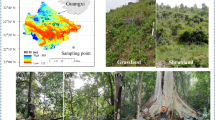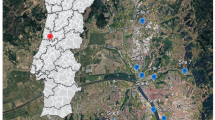Abstract
Although zonation patterns of the standing vegetation along a water depth gradient in wetlands have been well described, few studies have explored whether such patterns also occur in the seed bank. This study examined patterns of the seed bank along a water depth gradient in three vegetation types (submerged zone, floating-leaved zone, and emergent zone) of a subtropical lakeshore marsh, Longgan Lake, China. Submerged zone is the deepest water and never exposed its soil to air, and was dominant by submerged species; floating-leaved zone is waterlogged soil even during drawdown and was dominant by Nelumbo nucifera; emergent zone is rarely exceeded 1 m water depth during the wet season (summer and autumn), and the marsh soil was usually exposed to air during drawdown (winter and spring), and is dominant by Zizania latifolia, Polygonum hydropiper and Scirpus yagara. It was found that many species were ubiquitous in the seed bank. Frequency of distribution and densities of the dominant species, however, varied significantly from zone to zone. A total of 22 species was recorded in submerged zone, 20 in floating-leaved zone, and 29 in emergent zone. Germinated seedling density was 1,580, 8,994 and 20,424 seedlings m−2 in submerged zone, floating-leaved zone, and emergent zone, respectively. Submerged and floating-leaved species were significantly abundant in the submerged zone, while the emergent species were found predominantly in the emergent zone. A fern species, Ceratopsis pterioides, was the most abundant seedling in seed banks from all three zones. A TWINSPAN dendrogram and CCA ordination diagram clearly showed separation of species among sites with the emergent zone being well separated from the submerged zone and floating-leaved zone, thus revealing marked zonal patterns in species distributions in the seed bank. This pattern of zonation reflected the pattern in the standing vegetation.
Similar content being viewed by others
References
Britton DL, Brock MA (1994) Seasonal germination from wetland seed banks. Aust J Mar Freshwater Res 45:1445–1459
Brock MA (1991) Mechanisms for maintaining persistent populations of Myriophyllum variifolium in a fluctuating shallow Australian lake. Aquat Bot 39:211–219
Brock MA, Casanova MT (1991) Vegetative variation of Myriophyllum variifolium in permanent and temporary wetlands. Aust J Bot 39:487–496
Brock MA, Casanova MT (1997) Plant life at the edges of wetlands; ecological responses to wetting and drying patterns. In: Klomp N, Lunt I (eds) Frontiers in ecology: building the links. Elsevier Science, Oxford, pp 181–192
Boedeltje G, ter Heerdt GNJ, Bakker JP (2002) Applying the seedling-emergence method under waterlogged conditions to detect the seed bank of aquatic plants in submerged sediments. Aquat Bot 72:121–128
Casanova MT, Brock MA (1990) Charophyte germination and establishment from the seed bank of an Australian temporary lake. Aquat Bot 36:247–254
Chang ER, Jefferies RL, Carleton TJ (2001) Relationship between vegetation and soil seed banks in an arctic coastal marsh. J Ecol 89:367–384
Dyer AF, Lindsay S (1992) Soil spore banks of temperate ferns. Am Fern J 82:89–123
Galinato ML, van der Valk AG (1986) Seed germination traits of annuals and emergents recruited during drawdowns in the delta marsh, Monitoba, Canada. Aquat Bot 26:89–102
Gauch HG (1982) Multivariate analysis in community ecology. Cambridge Univ. Press, Cambridge, UK
Goldsmith FB, Harrison CM (1976) Description and analysis of vegetation. In: Chapman SB, (eds) Methods in plant ecology. Blackwell Science, Oxford, United Kingdom, pp 85–155
Grace JB, Wetzel RG (1981) Habitat partitioning and competitive displacement in cattails (Typha): experimental field studies. Am Nat 118:463–474
Keddy PA, Constabel P (1986) Germination of ten shoreline plants in relation to seed size, soil particle size and water level: an experimental study. J Ecol 74:133–141
Keddy PA, Ellis TH (1985) Seedling recruitment of 11 wetland plant species along a water level gradient: shared or distinct responses? Can J Bot 63:1876–1879
Keddy PA, Reznicek AA (1982) The role of seed banks in the persistence of Ontario’s coastal plain flora. Am J Bot 69:13–22
Keddy PA, Reznicek AA (1986) Great Lakes vegetation dynamics: the role of fluctuating levels and buried seeds. J Great Lakes Res 12:25–36
Leck MA, Brock MA (2000) Ecological and evolutionary trends in wetlands: evidence from seeds and seed banks in New South Wales, Australia and New Jersey, USA. Plant Species Biol 15:97–112
Leck MA, Simpson RL (1987) Seed bank of a freshwater tidal marsh. Am J Bot 74:360–370
Leck MA, Simpson RL (1994) Tidal freshwater wetland zonation: seed and seedling dynamics. Aquat Bot 47:61–75
Li W (1995) Studies on aquatic vegetation and its succession in Honghu Lake, Ph.D. dissertation. Institute of Hydrobiology, The Chinese Academy of Sciences, p 17
Liu GH, Li W, Wang XL, Zhang XJ (2004) Relationship between seed banks and standing vegetation in Huli marsh, Chaling, Hu’nan Province. Acta Ecol Sin 24:450–456
Liu GH, Zhou J, Li W, Cheng Y (2005) The seed bank in a subtropical freshwater marsh: implications for wetland restoration. Aquat Bot 81:1–11
Liu GH, Li W, Zhou J, Liu WZ, Yang D, Davy AJ (2006) How does the propagule bank contribute to cyclic vegetation change in a lakeshore marsh with seasonal drawdown? Aquat Bot doi:10.1016/j
McCune B, Mefford MJ (1999) PC-ORD. Multivariate analysis of ecological data. Version 4.32 MjM Software, Gleneden Beach, Oregon, USA
Milberg P (1991) Fern spores in a grassland soil. Can J Bot 69:831–834
Nicholson A, Keddy PA, (1983) The depth profile of a shoreline seed bank in Machedash Lake, Ontario. Can J Bot 61:3293–3296
Nicol JM, Ganf GG, Pelton GA (2003) Seed banks of a southern Australian wetland: the influence of water regime on the final floristic composition. Plant Ecol 168:191–205
Parker VT, Leck MA (1985) Relationship of seed banks to plant distribution patterns in a freshwater tidal wetland. Am J Bot 72:161–174
Poiani KA, Johnson WC (1989) Effect of hydroperiod on seed-bank composition in semipermanent prairie wetlands. Can J Bot 67:856–864
Schneider R (1994) The role of hydrologic regime in maintaining rare plant communities of New York’s coastal plain pondshores. Biol Conserv 68:253–260
Seabloom EW, Moloney KA, van der Valk AG (2001) Constraints on the establishment of plants along a fluctuating water-depth gradient. Ecology 82:2216–2232
Seabloom EW, van der Valk AG, Moloney KA (1998) The role of water depth and soil temperature in determining initial composition of prairie wetland coenoclines. Plant Ecol 138:203–216
Shipley B, Keddy PA, Lefkovitch LP (1991) Mechanisms producing plant zonation along a water depth gradient: a comparison with the exposure gradient. Can J Bot 69:1420–1424
Smith LM, Kadlec JA (1983) Seed banks and their role during drawdown of a North American marsh. J Appl Ecol 20:673–684
Sørensen T (1948) A method of establishing groups of equal amplitude in plant sociology based on similarity of species content and its application to analyses of the vegetation on Danish commons. Det Kongelige Danske Videnskabernes Selskab. Biologiske Skrifter 5(4):1–34
Spence DHN (1982) The zonation of plants in freshwater lakes. Adv Ecol Res 12:37–125
Squires L, van der Valk AG (1992) Water depth tolerances of the dominant emergent macrophytes of the Delta Marsh, Manitoba. Can J Bot 70:1860–1867
Thompson K (1992) The functional ecology of seed banks. In: Fenner M (ed) The ecology of regeneration in plant communities, C.A.B. International, pp 231–258
van der Valk AG, Davis CB (1976) The seed banks of prairie glacial marshes. Can J Bot 54:1832–1838
van der Valk AG, Davis CB (1978) The role of seed banks in the vegetation dynamics of prairie glacial marshes. Ecology 59:322–335
van der Valk AG, Davis CB (1979) The role of seeds banks in the vegetation dynamics of prairie glacial marshes. Ecology 59:322–335
van der Valk AG, Welling CH (1988) The development of zonation in freshwater wetlands: an experimental approach. In: During HJ, Werger MJA, Willems HJ (eds) Diversity and pattern in plant communities. S.P.B. Publishers, The Hague, The Netherlands, pp.␣145–158
Welling CH, Pederson RL, van der Valk AG (1988b) Recruitment from the seed bank and the development of zonation of emergent vegetation during drawdown in a prairie marsh. J Ecol 76:483–496
Zhang SZ, Dou HS, Jiang JH (1996) Aquatic vegetation in Longgan Lake. J Lake Sci 6:161—168
Acknowledgments
We thank Y.P. Liu, J.W. Xu, W.Z. Liu, X.S. Ke and W.Y. Wu for field assistance; T.Y. Li and Y. Cheng for species identification, two anonymous reviewers for their helpful criticism at this manuscript. Financial support was provided by the Innovation Key Project of CAS (KZCX1-SW-12, KSCX2-1-10) and The State Key Basic Research and Development Plan of China (2002CB412300).
Author information
Authors and Affiliations
Corresponding author
Appendix 1
Appendix 1
Rights and permissions
About this article
Cite this article
Yuan, LY., Liu, GH., Li, W. et al. Seed Bank Variation Along a Water Depth Gradient in a Subtropical Lakeshore Marsh, Longgan Lake, China. Plant Ecol 189, 127–137 (2007). https://doi.org/10.1007/s11258-006-9170-z
Received:
Accepted:
Published:
Issue Date:
DOI: https://doi.org/10.1007/s11258-006-9170-z




